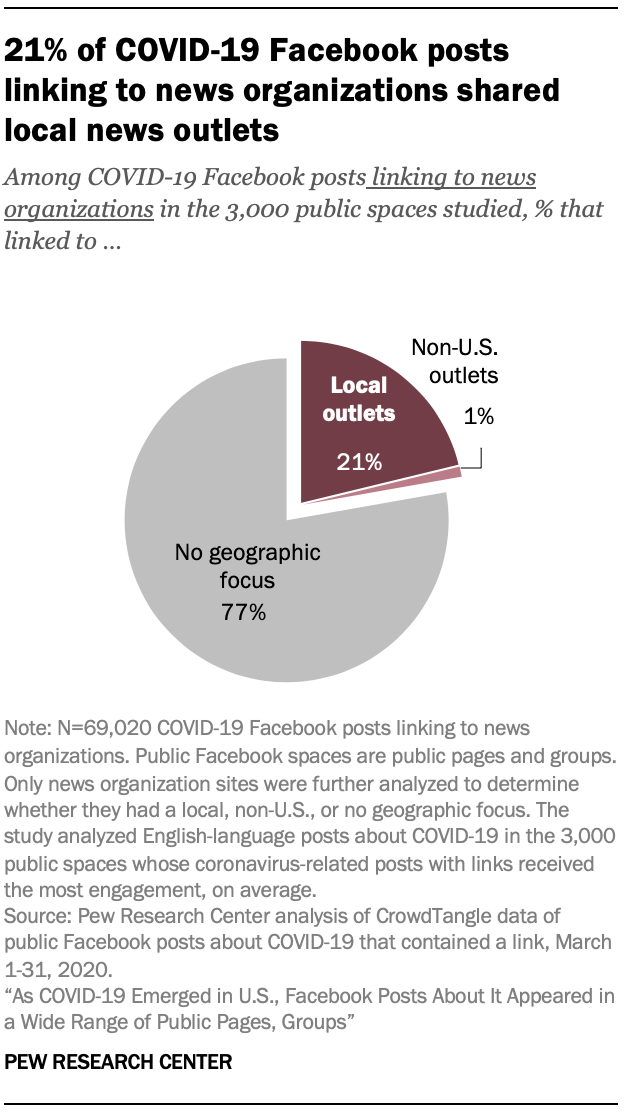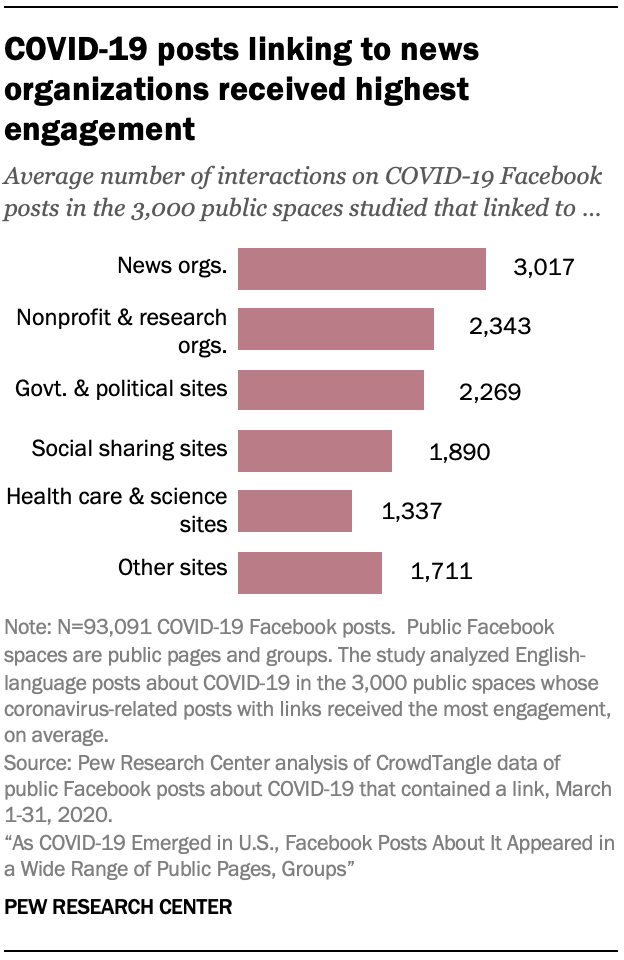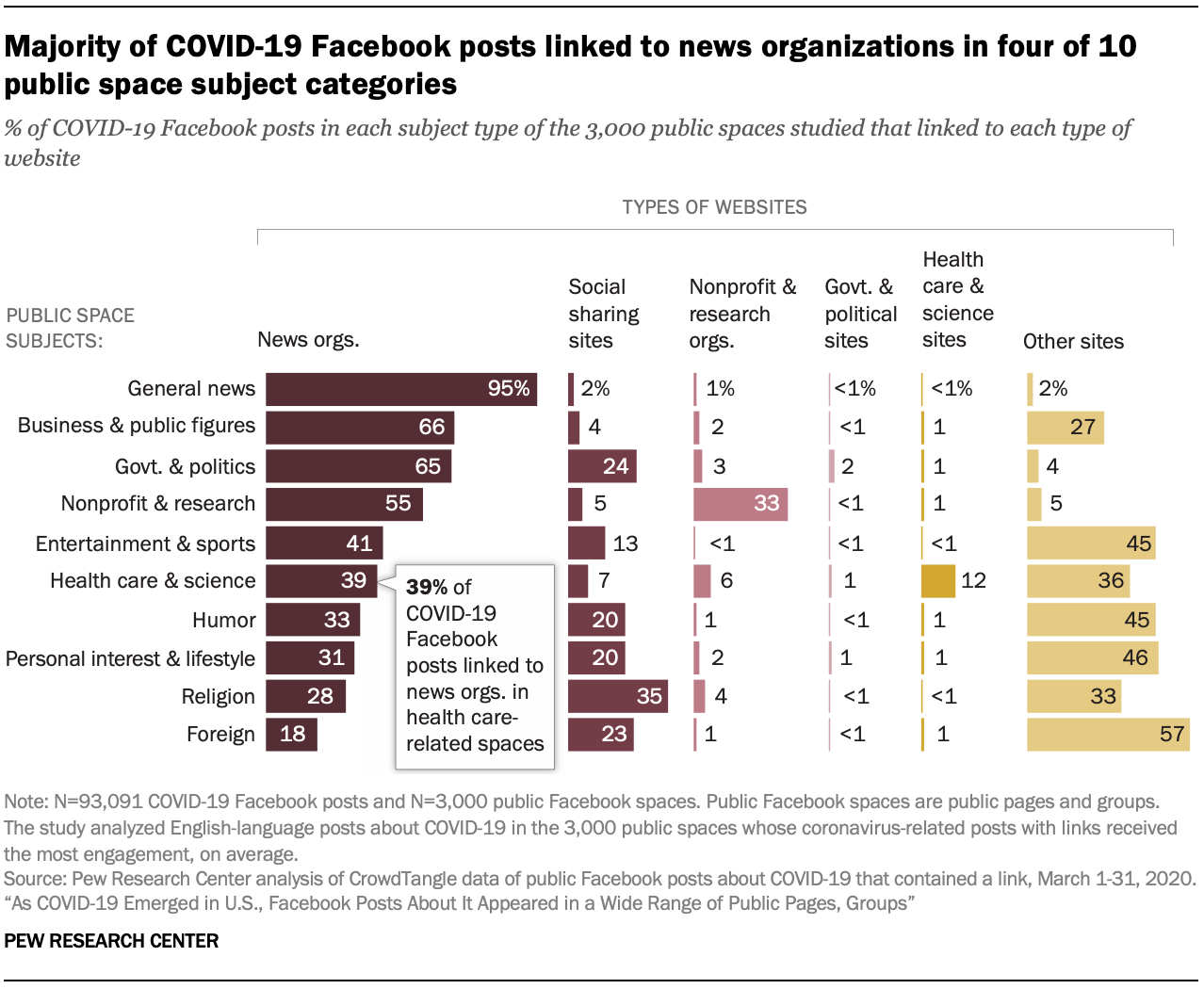
As the threat from the coronavirus became evident, Facebook users posting about the outbreak largely turned to news media sources for information to understand the developments. Links to news organizations were shared in far more COVID-19 posts than links to other kinds of source types, and posts that linked to news organizations received more interactions, on average, than posts to any other source type.
Across the 3,000 public Facebook spaces studied, there were 93,091 posts about COVID-19 that also contained a link. These sites were categorized into 20 mutually exclusive groupings across six broad categories. These broad categories are news organizations, social sharing sites, nonprofit and research organizations, health care and science sites, government and political sites, and other sites.
About three-quarters (74%) of the coronavirus-related Facebook posts with links from March 2020 linked to news organizations, including network and cable news outlets, newspapers, radio, and digital media. Far fewer posts (9%) linked to social media sites, discussion boards, or other online places where users upload content (called social sharing sites here). Even fewer linked to nonprofit or research organizations (3%), while just 1% of posts linked to health care sites, including the websites of public health agencies like the CDC, doctors, hospitals and other medical resources.
The study also dug deeper into what types of news organizations were being featured in Facebook posts. TV station sites (28%) and digital native news organizations (24%) were linked to more frequently than the online presence of print publications (15%) or other news organizations (6%). (See detailed tables for full results.)

And while most posts that linked to these news outlets did not have a geographic focus (77%), local news organizations played a key role, showing the continued faith that Americans place in the news media that cover their communities – even during a global pandemic. About one-in-five of those posts linking to news organizations (21%) linked to a local news organization such as a local TV or radio station or a local newspaper.
Coronavirus-related Facebook posts that linked to news organizations tended to get more engagement

The level of interaction posts receive is also an important indicator of their impact. Here again, news organizations stand out. Facebook posts about the coronavirus that linked to news organizations tended to draw more attention, in the form of comments, shares, or reactions, than posts to any other broad type of site.
The average COVID-19 post linking to a news organization received about 3,000 interactions – 29% more than the next highest category. And a look at one specific interaction metric – the average number of times a post is shared – underscores the extent to which news organizations were part of the conversation. Posts that linked to news organizations were shared an average of 855 times, far outpacing the shares of the next highest category (nonprofit and research organizations, with an average of 588 shares per post). (See detailed tables for full results.)
The other broad categories of sites received fewer interactions than news organizations. Posts linking to nonprofit and research sites received 2,343 interactions, on average, while posts linking to government and political sites received 2,269. Those that linked to user-produced sites, like social media, blogs, and discussion boards, received 1,890 interactions, on average.
When linking to health care and science sites – such as public health agencies, medical professionals and medical information sites – posts about COVID-19 tended to receive the fewest interactions: 1,337 per post. More specifically, posts to public health sources like the CDC, World Health Organization, and state and local health agencies that are directing the response to the pandemic or providing coronavirus-related resources received even less engagement: an average of 756 interactions per post. (See detailed tables for full results.)
One of the specific groupings in the “Other sites” category stands out: Despite the gravity of the pandemic – or maybe because of it – Facebook users were drawn to humorous posts. Posts that linked to satirical or humor sites, such as The Onion or McSweeney’s, had a higher average interaction rate (6,287) than any other specific category of site. (See detailed tables for full results.)
News organizations were a common source type in COVID-19 Facebook posts in public spaces oriented around different subjects
Facebook users’ reliance on news organizations in coronavirus-related posts cuts across many of the different subjects around which public spaces are oriented. News organizations were linked to in a majority of posts in four of the 10 subject categories, and they were the first- or second-most common type of link destination in all but the spaces about foreign issues or religion.

In public spaces oriented around general news, nearly all coronavirus-related posts (95%) linked to news organizations. In the other public spaces studied, posts linked to news organizations to a lesser extent. About two-thirds of the posts in spaces about businesses and public figures (66%) or government and politics (65%) linked to news organizations, while just over half (55%) of posts in nonprofit and research-oriented spaces linked to news sites. In public spaces dedicated to health care and science issues, 39% of the posts linked to news organizations.
Despite the medical questions surrounding the novel coronavirus, health care-related sites were linked to rarely in each category. The only types of public spaces in which more than 1% of posts linked to health care sites were those about health care and science issues.




